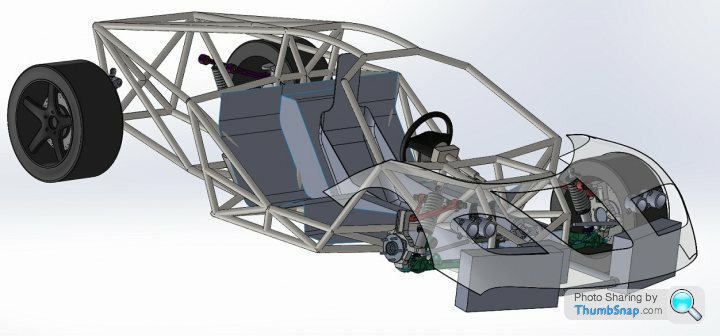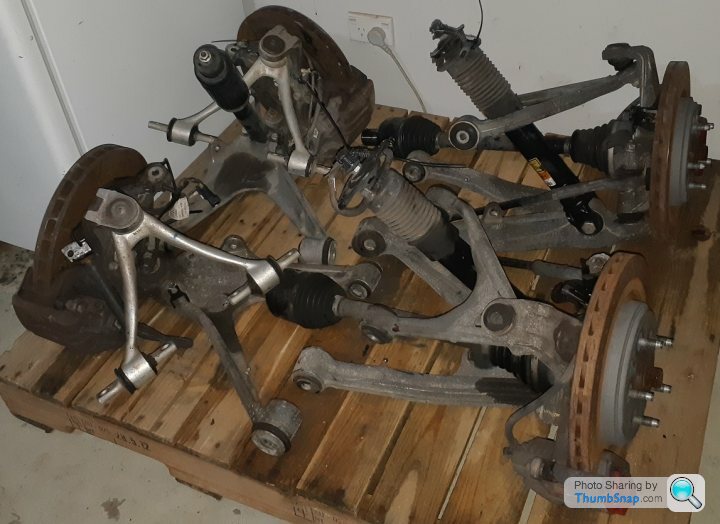540HP NA 7L V12 3 seater
Discussion

Been running multiple iterations of chassis tubing to match loads and positions - everything is slotting in nicely after 743 attempts. The rolling chassis gokart is looking to be around 976kg with no bodywork. Weight distribution is coming out around 43f/57r.
Edited by F1natic on Wednesday 11th September 12:45
bern said:
Having said that! I'd have to put something like this on top of it and it's still a tribute to Bruce. Win, win!
What about when it rains??? No issue if you keep it pegged! Bruce and his team knew how to make them right, form follows function. I still can't make it through the McLaren film by Roger Donaldson with a dry eye. I grew up in NZ in the 70's with Canam toy cars - I think it seriously programmed my brain as to what a car should look like. For a road car application it needs better crash structures. Cheers!Astacus said:
Maybe you could think about bonding a layer of fibreglass tissue to the buck before you shape with filler, to provide a more solid base. The resin will soak into the cardboard and strengthen the outer few mm too.
Nice idea, thanks. I will give that a try on some of the half scale tooling block trials.Edited by F1natic on Wednesday 11th September 18:47
https://www.roadandtrack.com/car-culture/car-desig...
By total chance I just found the article above - ironically it turns out that during the concept stage the Mclaren roadcar team had discussed using 2 x NSX V6 engines......
By total chance I just found the article above - ironically it turns out that during the concept stage the Mclaren roadcar team had discussed using 2 x NSX V6 engines......
Ahem, unfortunately the weight keeps climbing - I have been adding a lot of extra tubes to the chassis. I have been watching Side Pole Crash Tests on you tube and am beefing up the passenger protection (no worries for the driver as they are so far from the crush zone).
I have a rear axle limit that I cannot exceed of 840 KG (fully laden Corvette is 3700lbs split 50/50 so certifier won't sign off if the vehicle axle load exceeds that). With the weight distribution of 43/57 that gives a total laden mass of 1473 kg. I am targeting 1300 but my certifier (www.fraser.co.nz) thinks that roadgoing body work will really push that target. While I do the chassis development the car will just be a exo spaceframe car much like the 3 balls track monster shown below - that will hopefully give me a chance to garner some assistance with carbon fibre panels.
Since the go kart is coming in at just under 1000kg, I have 300 kg of bodywork allowance - I am trying to be realistic as this is my first build (that's an oxymoron). Mclaren had a development budget of 8.5 million GBP, mine is a little lower so I will be happy if the wheels turn! I agree with Gordon Murray that weight to power is a critical factor - but for praticality I have to forego some of extremely low weight goals for "doable" & "affordable". I think on the performance to price factor it should be fairly well placed compared to other sportscars. Also as this is a development vehicle I don't see it ever being "finished" and therefore the final weight doesn't exist!
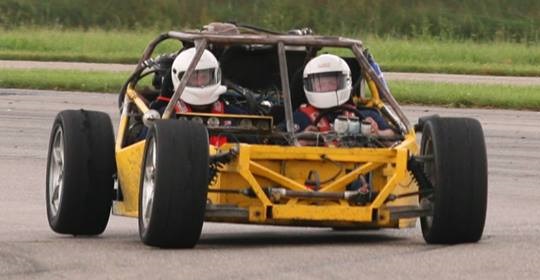
I have a rear axle limit that I cannot exceed of 840 KG (fully laden Corvette is 3700lbs split 50/50 so certifier won't sign off if the vehicle axle load exceeds that). With the weight distribution of 43/57 that gives a total laden mass of 1473 kg. I am targeting 1300 but my certifier (www.fraser.co.nz) thinks that roadgoing body work will really push that target. While I do the chassis development the car will just be a exo spaceframe car much like the 3 balls track monster shown below - that will hopefully give me a chance to garner some assistance with carbon fibre panels.
Since the go kart is coming in at just under 1000kg, I have 300 kg of bodywork allowance - I am trying to be realistic as this is my first build (that's an oxymoron). Mclaren had a development budget of 8.5 million GBP, mine is a little lower so I will be happy if the wheels turn! I agree with Gordon Murray that weight to power is a critical factor - but for praticality I have to forego some of extremely low weight goals for "doable" & "affordable". I think on the performance to price factor it should be fairly well placed compared to other sportscars. Also as this is a development vehicle I don't see it ever being "finished" and therefore the final weight doesn't exist!

Edited by F1natic on Saturday 21st September 22:05
at 1300kg + 2 passengers at 86.5 kg each I am at the rear axle limit.
As an example of doing it the other way round - check out 6:33
https://www.youtube.com/watch?v=UfpQTAFoTU4
Hotrod lost 893 lbs (382 Kg) of bodywork on a C4 - that had air con and stereos and carpets etc.
As an example of doing it the other way round - check out 6:33
https://www.youtube.com/watch?v=UfpQTAFoTU4
Hotrod lost 893 lbs (382 Kg) of bodywork on a C4 - that had air con and stereos and carpets etc.
Kubevoid said:
With some tuning parts I have reached a tested 300bhp in NA.
Thanks for the support!I am impressed with your build, your engine bay looks factory! Could you detail what you did to coax the extra HP out? Might have to change the title of my thread to 600HP NA. Most interested to find out your ECU setup too, could not find a build thread here, do you have one? Cheers.
The whole point of 2 motors is to achieve 7L capacity NA responsiveness - with stock engine reliability. As you well know the J series is not a stressed design and can take a lot of extra load - or standard gives longevity. I am going for long term goals - hence not wanted to stress a single unit to high levels.
Roughed out the front crash structure tonight. It is thick wall aluminium tubing running forward of the steel frame and will position the concealed front aluminium bumper that will absorb some frontal impact energy if the worse should happen (certification requirement is for provision of a frontal absorbing structure - luckily no actual testing has to be conducted to test its effectiveness). The bumper structure will also rigidly mount the headlights and the radiators. This shot shows the right front wheel in full bump and lock and there is no fouling with bodywork - tick.
The upper control arm will mount onto a separate cnc spacer plate that bolts to the frame - this will allow easy configuration for front camber and caster experiments - intend to start with the baseline C6 settings which are -0.7 to -0.9 deg camber and 9 degrees caster. Scrub radius on the 265/35/18 front tire is 10mm with kingpin angle of 10.3 deg.
Headlights will be 90mm Hella LED projector units.
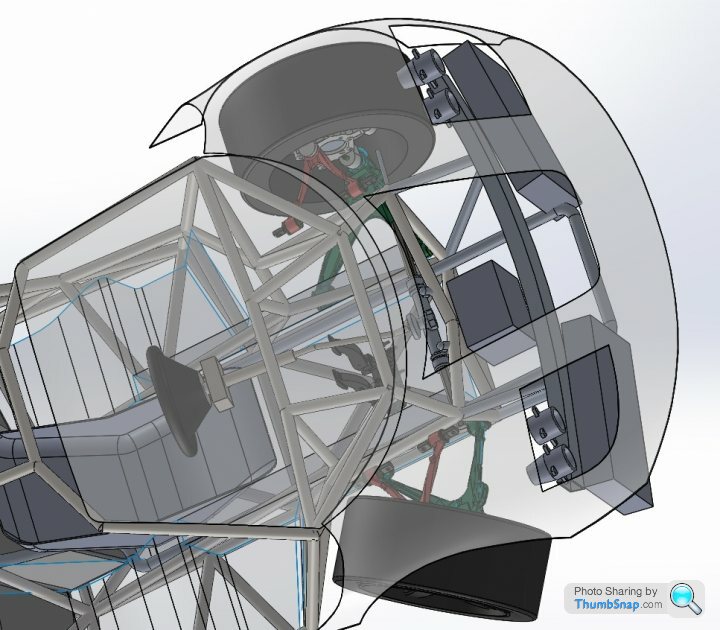
The upper control arm will mount onto a separate cnc spacer plate that bolts to the frame - this will allow easy configuration for front camber and caster experiments - intend to start with the baseline C6 settings which are -0.7 to -0.9 deg camber and 9 degrees caster. Scrub radius on the 265/35/18 front tire is 10mm with kingpin angle of 10.3 deg.
Headlights will be 90mm Hella LED projector units.

Edited by F1natic on Wednesday 25th September 12:43
Caddyshack said:
What steering rack will you use.
Modelled is a Porsche 911 unit that I was donated by a friend, it is too narrow but will be used for the suspension pickup test = a bunch of steel box section in the positions the cad says is good so that I can confirm the behaviour in bump and roll before signing off on the dimensions and committing them to the frame proper.My certifier had an Ariel atom in the workshop and the Titan rack is what he wants to see in there. They have full customized ordering so will get exactly what I need, which is good as steering is important right?
LaurasOtherHalf said:
On nights when I can’t sleep I day (night?) dream about building something bespoke with a central driving position.
For the link to the F1 I always go back to a BMW V10 as the power plant. For no more reason than I think it’s criminal it didn’t go into anything saying much less than a two ton car!
I guess still to long with a traditional gearbox op?
Yup, I too spend a lot of my brainpower pondering on this adventure.For the link to the F1 I always go back to a BMW V10 as the power plant. For no more reason than I think it’s criminal it didn’t go into anything saying much less than a two ton car!
I guess still to long with a traditional gearbox op?
I never contemplated a V10, have driven a 2015 ACR Viper and that thing is fantastic, however any longitudinal engine really pushes the trans out the back in a middy, and center of mass moves back with it, any conventional engine-diff-gearbox combo is going to suffer what the F1 design team so brilliantly avoided. The BMW v10 sounds great and would be a great choice of powerplant.
Same goes for V8's, I want NA cubic displacement so the contenders all suffer the same rearward bias effect.
The new corvette C8 transmission in a few years will be the ideal starting point for a mid engine homebuilder, however I love manual boxes too much to change course now.
Been too busy with day job (end of financial year) so no decent progress to report, unlike Danie in SA!
I think his implementation of the engine/gearbox is brilliant, using an Audi Q7 transaxle - looks good.
https://www.youtube.com/watch?v=sjhiMHMqFmI&t=... - he deserves some major likes and subscribes.
I think his implementation of the engine/gearbox is brilliant, using an Audi Q7 transaxle - looks good.
https://www.youtube.com/watch?v=sjhiMHMqFmI&t=... - he deserves some major likes and subscribes.
samoht said:
A couple of cars you might consider examining closely for inspiration / parts:
- the Cizeta Moroder V16 is the only other car I know of like this, two Lambo V8 engines mounted transversely driving a transaxle, very similar layout to what you're thinking. So it proves it can work, and the way they did it might be worth looking at.
- I think the Porsche 917 has a central power takeoff, being formed from two flat sixes
- McLaren closely based the F1 greenhouse on the Toyota Sera, which also has doors that open that way. So you could just possibly use parts of that car for your greenhouse? Could be a shortcut to a set of glass and doors, seals etc that fit together properly without leaks.
Thanks for the excellent images, I had not seen such a good shot of the bare cizeta block before. The V16T was an early inspiration, however I do not want to attempt full integration of the cranks and blocks. Keeping the engines as separate "plug and play" units frees me up in the future, so the Tbox unit can be adapted to suit any pair of engines.- the Cizeta Moroder V16 is the only other car I know of like this, two Lambo V8 engines mounted transversely driving a transaxle, very similar layout to what you're thinking. So it proves it can work, and the way they did it might be worth looking at.
- I think the Porsche 917 has a central power takeoff, being formed from two flat sixes
- McLaren closely based the F1 greenhouse on the Toyota Sera, which also has doors that open that way. So you could just possibly use parts of that car for your greenhouse? Could be a shortcut to a set of glass and doors, seals etc that fit together properly without leaks.
I originally intended to build a replica Mazda 787B racecar with 2 x 20B Triple rotor engines - then you are talking insane power and super low COG - would probably go better than an original one! But decided to go this road car route as I will get more use out of it and it hopefully won't be so lethal.
Thanks for the Sera idea, unfortunately I don't think there are any in NZ.
Weighed the wet but mostly bare honda J35Z2 engine - 122kg. I am OK with that mass given were it sits in the car.
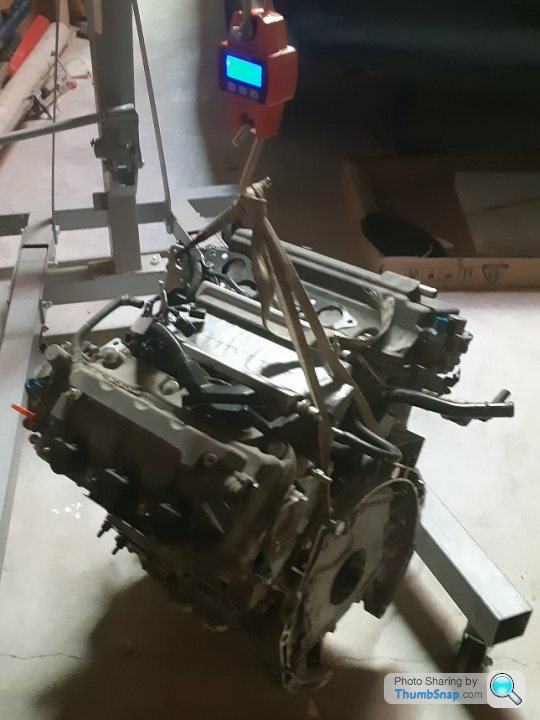
Have bought an old Xbox kinect unit that can be converted into a 3D scanner so I will be able to accurately scan the engine shown above.
Pulled a J32A1 head from a 225hp 1999 honda saber at the wreckers - intending to use it as a sacrificial lamb to explore head porting, cam and flowbench improvements as it wasn't the high power J32A2. Not sure how well the ports will scan - not a high priority. Will post some pics of the cabin mock up shortly.
small progress update - I am currently building the inner rear bulkhead mould plug which incorporates the inner tub spars and the passenger seats. My carpentry skills are improving slowly - hence no photos yet. The mockup of the entry and exit technique has proven useful as the outer sills were 50mm too high - and the most comfortable method of entry and exit is to approach the door aperture front on, bend forward and place you left hand onto the passenger seat, spin around and plant your rear onto the front edge of the seat, draw your legs in and swivel them around into the drivers position, then lift your upper body over into the drivers seat. Regulations require exiting the vehicle in 7 seconds, I am achieving 5 seconds comfortably. However this will not be possible with a passenger so I will have to apply for a technical "exemption" for this requirement as 3 seaters were not in the minds of the regulators when they wrote the rulebook.
My first impression of the setup is how outstanding and unrestricted the front vision is. I welded a perimeter frame that matches the CAD dimensions around the windscreen and over the drivers head and everything was at comfortable distances. I am 5'8" and had plenty of headroom. Once the mould plug is finished I can optimise the final position of the spaceframe tubing for components like seat and seatbelt mounts, steering column brackets etc. then complete the load calculations for the frame and submit my build application.
Since the transverse V6's take up most of the space that the original F1 uses for luggage storage I am working to make the frunk as capacious as possible - there is not really anywhere else to make decent storage compartments. But chances are that long distance travel will be with only one passenger so the spare seat can be utilised.
My first impression of the setup is how outstanding and unrestricted the front vision is. I welded a perimeter frame that matches the CAD dimensions around the windscreen and over the drivers head and everything was at comfortable distances. I am 5'8" and had plenty of headroom. Once the mould plug is finished I can optimise the final position of the spaceframe tubing for components like seat and seatbelt mounts, steering column brackets etc. then complete the load calculations for the frame and submit my build application.
Since the transverse V6's take up most of the space that the original F1 uses for luggage storage I am working to make the frunk as capacious as possible - there is not really anywhere else to make decent storage compartments. But chances are that long distance travel will be with only one passenger so the spare seat can be utilised.
Edited by F1natic on Friday 10th January 09:34
Spent some summer holiday reworking the mockup cabin and adjusting the CAD model to the fullsize values, and sitting in it has made me realise I can add some extra beam strength to the chassis by augmenting the steel frame with some carbon honeycomb spars on the inside edges of the drivers tub and running these up the sides of the fuel tank hump.
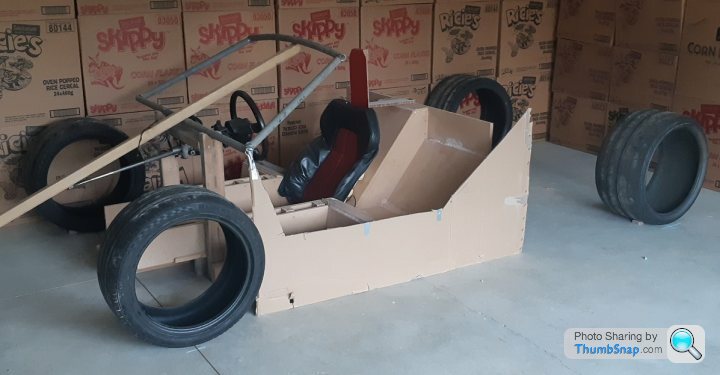
The passenger seating is really comfortable and there is ample clearance between the drivers elbows and the passenger knees, although the gear change gets really close and passengers will probably be advised to skew their legs off to the outer area of the footpanel.
No, I didn't eat all those cornflakes - the boxes will be cut into the door outer skin profiles once I have build approval from LVVTA.
The chassis is up to Version 8 - and weighs 154 kg. Total dry weight for the track mule should be just under 900kg - so am confident that I can hit the 1300kg curb weight target with bodywork.
Now that the seat size and positions are frozen I can place all the seat and seatbelt retaining bolt bosses - critical for safety as restraints and mounts have to withstand 20G loading according to NZ regulations. The door hinge sizes and positions have been determined as these are another critical item for the certifier to have calcs on.
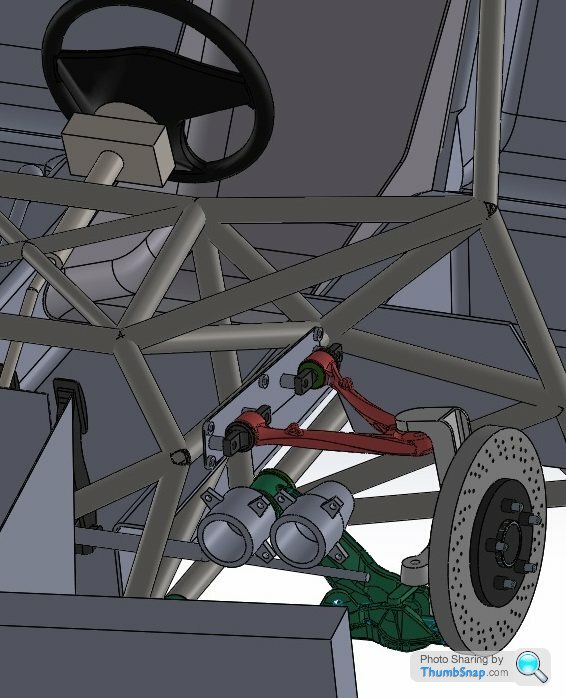
Shown above is rough detail on the CNC cut interchangeable camber and caster plates (will put some stiffening ribs between the bosses later) - these "bolt in" plates give lots of scope for fine tuning of the front end geometry without touching the chassis. Goal is to get the manual steering as light as possible while still having good straightline and heavy braking stability. The steering rack will be similarly adjustable on interchangeable plates so that bump steer is minimised.

The passenger seating is really comfortable and there is ample clearance between the drivers elbows and the passenger knees, although the gear change gets really close and passengers will probably be advised to skew their legs off to the outer area of the footpanel.
No, I didn't eat all those cornflakes - the boxes will be cut into the door outer skin profiles once I have build approval from LVVTA.
The chassis is up to Version 8 - and weighs 154 kg. Total dry weight for the track mule should be just under 900kg - so am confident that I can hit the 1300kg curb weight target with bodywork.
Now that the seat size and positions are frozen I can place all the seat and seatbelt retaining bolt bosses - critical for safety as restraints and mounts have to withstand 20G loading according to NZ regulations. The door hinge sizes and positions have been determined as these are another critical item for the certifier to have calcs on.

Shown above is rough detail on the CNC cut interchangeable camber and caster plates (will put some stiffening ribs between the bosses later) - these "bolt in" plates give lots of scope for fine tuning of the front end geometry without touching the chassis. Goal is to get the manual steering as light as possible while still having good straightline and heavy braking stability. The steering rack will be similarly adjustable on interchangeable plates so that bump steer is minimised.
Yes indeed, it is in fact impossible not to. It may look rough as guts but the buck has served it's purpose and I built it for a pittance. Money spent prototyping is always saved later in the real build.
I have had to stretch the wheelbase slightly due to the lack of late model corvette transaxles appearing on Ebay - it is now bang on 9ft (108"). When funds allow I will be stumping up for a C7 ZO6 box (TR6070) as it is the same price as the weaker C6 box. Therefore the vehicle will have a 7 speed manual gearbox, with 3 overdrives. 3 overdrives is pointless as top speed is achieved in 5th gear - but it gives me future opportunity to change the rear end ratio from the stock 3.42 to a 4.1. The C7 "e-diff" is better as it incorporates hydraulic actuation of the clutch pack, so is very easy to make on the fly changes to rear end settings during the test mule development runs - for the same outlay as a C6 unit. Also the support castings are stronger.
I have had to stretch the wheelbase slightly due to the lack of late model corvette transaxles appearing on Ebay - it is now bang on 9ft (108"). When funds allow I will be stumping up for a C7 ZO6 box (TR6070) as it is the same price as the weaker C6 box. Therefore the vehicle will have a 7 speed manual gearbox, with 3 overdrives. 3 overdrives is pointless as top speed is achieved in 5th gear - but it gives me future opportunity to change the rear end ratio from the stock 3.42 to a 4.1. The C7 "e-diff" is better as it incorporates hydraulic actuation of the clutch pack, so is very easy to make on the fly changes to rear end settings during the test mule development runs - for the same outlay as a C6 unit. Also the support castings are stronger.
Edited by F1natic on Monday 3rd February 04:39
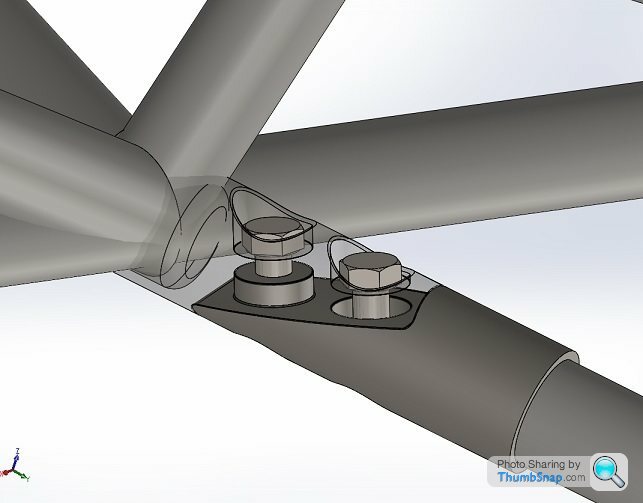
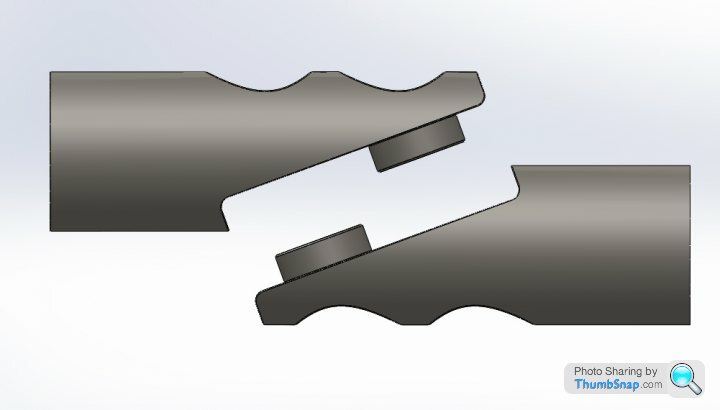
Work has continued in the background - last week I finally made a bolted joint design I was happy with between the rear engine subframe and the main spaceframe. The bolts are purely in tension, sideloads and tube torques are reacted by the matching bosses and recesses. I will 3D print a few of these and get them cast in 4130 then weld into a test setup with the 4130 tubing I am going to use and progressively load test up to yield then destruction to correlate my stress calcs with real world results.
The intention is to have the main spacefame and rear engine subframe internally pressurized with argon and monitor for cracks using a pressure sensor/gauge as porsche did with the 917. The frame will likely be painted white to make inspection of the critical junctions easy to assess during maintenance checks.
The frame configuration is frozen, just working through all the fine detail of mounting the little items, such as wiper motors, fuel fillers and vents. Thanks to some PH members input I was guided to source a Jaguar XK8 fly-off handbrake, which will help in getting into the drivers position with the handbrake applied. The exhaust tubing passes quite close to the back of the passenger bulkhead seats, so heat soak is going to be a big challenge to manage, although I won't be resorting to gold lining - more likely multilayered heat shields fed with adequate cold air. Will be nice for passengers in winter though.....
Edited by F1natic on Saturday 7th March 08:51
jase_llan said:
What about a VW W12? It's essentially two VR6 engines and is pretty compact, and despite being a more complex beast I would have thought a Phaeton could be procured cheaply enough?
Then again, I like the twin engine idea and am confident you'll succeed!
They are a great powerplant, I will have to look deeper at the compatible audi gearbox options, typically in the high horsepower ranges a manual gearbox is not an option. Cheapest W12 vehicle in NZ is $40,000 compared to $1,700 for 2 engines off the shelf.Then again, I like the twin engine idea and am confident you'll succeed!
Also it is going to be quite cost effective to modify the honda SOHC camshafts to give more lift in the VTEC upper range by grinding the base circle of the standard road cams - I am confident that 600 total engine horsepower will be achieved without turbos - and thus retain the 7L naturally aspirated engine response.
However by the time I get this project rolling under its own power it may be mandatory to have an electric motor...
Gassing Station | Readers' Cars | Top of Page | What's New | My Stuff




